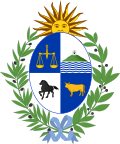
Back ثقافة الأوروغواي Arabic Cultura de l'Uruguai Catalan Cultura de Uruguay Spanish فرهنگ در اروگوئه Persian Culture de l'Uruguay French Cultura do Uruguai Portuguese
This article needs additional citations for verification. (November 2020) |
| This article is part of a series on the |
| Culture of Uruguay |
|---|
 |
|
Uruguay Portal |
|
|
The culture of Uruguay is diverse since the nation's population is one of multicultural origins. Modern Uruguayan culture is known to be heavily European influenced, mostly by the contribution of its alternating conquerors, Italy, Spain and Portugal, and from the large numbers of immigrants who arrived in the country from the 19th century onwards.
From the year 1858 to 1950 large waves of European immigrants began arriving to Uruguay, with the majority of the immigrants coming from Italy. Minor European immigrant groups – French, Germans, Swiss, Russians, Jews, and Armenians, among others – also migrated to Uruguay. The settlement of the European immigrants has resulted in traditions that integrate this diversity with the indigenous people or Charrúa elements. Uruguay has century-old remains and fortresses of the colonial era. Its cities have a rich architectural heritage, and a number of writers, artists, and musicians. Carnaval and candombe are the most important examples of African influence by slaves, as well as Umbanda religious beliefs and practices. Guarani traditions can be seen in the national drink, mate.